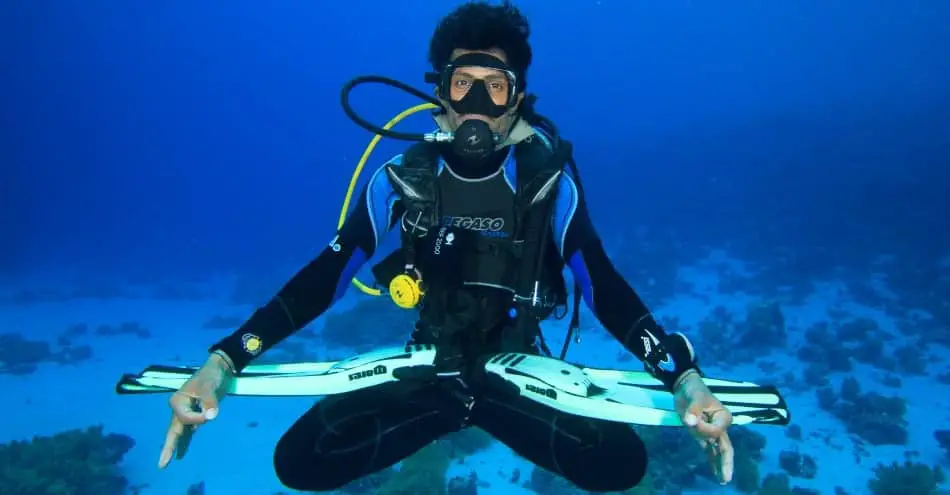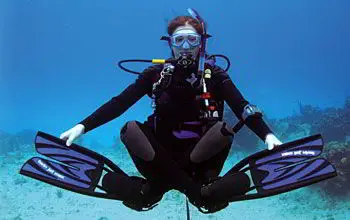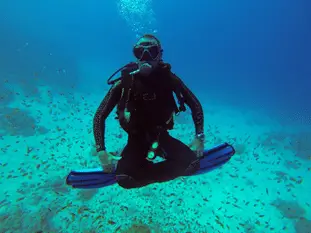Are you a new scuba diver looking for tips on how to increase buoyancy while diving?
Buoyancy is one of the challenging and hardest things to master when you’ve just got your water license.
It’s probably just like when you get your driver’s license, and you couldn’t even drive properly.
They will generally teach you first how to drive safely, but you need to be good driver overtime.
With that said, learning to ascend, descend and swim underwater is the key to have the best scuba diving performance.
Here’s our complete guide to buoyancy, with tips for helping you increase your buoyancy control while diving. So, let’s dive in.

What is Buoyancy?
Buoyancy is the capacity or propensity to float in water or air, or some other liquid.
Why is Buoyancy Control Important for Divers?
Buoyancy control is very important because it massively supports the diver’s security.
It helps to decreases effort while diving, allowing the divers to float effectively in the water section with strong control of their position.
Basics of Buoyancy
Increasing your buoyancy starts with getting the hang of the basics! After you have completed your initial scuba course, it’s time to become a good scuba diver.
Before you can transform into mastering buoyancy, you need to make sure that you understand the key guidelines directing how solid interchange partners with water.
Buoyancy suggests a thing propensity to float, sink, or don’t either. Because of scuba diving, there are three particular sorts of buoyancy that are of centrality;
Positive buoyancy implies diving skimming upwards towards the surface.
Negative buoyancy is where a diver sinks downwards towards the base. Neutral buoyancy is where a diver neither sinks nor floats. Yet rather remains suspended in the water at a comparative significance level.
At the point when you suit up, take a goliath walk and bounce into the sea, your body dislodges water. Simultaneously, the water encompassing your body tends to attempt to occupy the space that your body presently possesses. Therefore, your body is pushed upwards by a ‘light power”. Equivalent to the heaviness of the water that your body is uprooting. This is called Archimedes’ Principle.
As indicated by Archimedes’ Principle. An article drifts up if the heaviness of the water it uproots is more than its own weight. An item that sinks is the water’s heaviness it dislodges is not as much as its own weight. Finally, an item stays suspended at one level if it is a similar load at the heaviness of the water it uproots.
From the earliest starting point of the Open Water scuba course, divers are instructed to accomplish negative lightness for sliding and take a stab at nonpartisan lightness while diving at profundity.
Shockingly, we can’t just change from contrarily to impartially light spontaneously. So we use loads and a lightness compensator gadget (BCD) to help control our buoyancy.
Advantages of Buoyancy Control
Buoyancy control split up the experienced veterans and season pros from novice divers, and there is no doubt that any diver can master the most important.
At the point when a diver transforms into a competent control of buoyancy, they get different benefits.
Extended Safety: According to Diver’s Alert Network (DAN), overweight and poor softness are now and again contributing factors to scuba diving incidents. Incredible buoyancy reduces the risk of decompression ailment by helping divers control their ascension and dive rates.
Improved Air Consumption and Reduced Fatigue. Divers with awful softness will all in all flail uncontrollably and move their members a lot. This causes them to apply a lot of imperativeness and eat up the air quickly. Then again, fairly light divers don’t have to put forth a strong attempt to keep up their circumstance in the water, allowing them to spare air and essentialness, and defer their base events.
Secure Marine Environment: Divers with incredible delicacy don’t hurt delicate marine conditions by crashing into rocks and corals. Or maybe, they coast effectively through them. Taking in the sights as they go, zooming in close when they have to, and pulling out of nowhere and totally.
Better Diving Experience: Being prepared to control your improvements makes each hop progressively pleasant. Diving transforms into a logically slackened-up development. You can get a progressively basic gander at interesting marine animals, improving your trust in your abilities.

Tips on How to Increase Buoyancy while Diving
Weigh yourself properly
Wearing the perfect measure of weight is the absolute most significant factor when attempting to accomplish impartial lightness. It would help if you considered the entirety of the components all through a jump that will influence whether you will sink or buoy. Including the sort of introduction suit you will be wearing, the chamber’s size, how profound you will be going, and the sky is the limit from there.
At that point, you should pick the perfect measure of weight; to make up for the positive buoyancy of each.
Many divers’ teachers overweight their Open Water students to shield them from making an early visit to the surface. This makes checking simple for the diving teacher. Yet, it can make students leave the course thinking they require more weight than they really do.
Overweighed divers need to make up for additional load by placing more air into their CDs, making them progressively helpless to flighty lightness moves as they change profundities.
Know Your Equipment
The size and weight of each bit of jump gear impact your lightness. When in doubt, the heavier a bit of rigging, the more contrarily light you will be. The two bits of apparatus that have the best effect on buoyancy, other than the BCD, are the kind of presentation suit and air tank.
Wetsuits have little air bubbles contained inside the neoprene material that make them decidedly light. The thicker the wetsuit, the lighter it will be. A layer of protecting air gets caught between the jumper’s body and the suit with dry suits, likewise causing positive lightness. Both suites are very important for your comfort, health, and safety, but you need to know the difference between Wet and Drysuit so that you can pick the right to make your diving experience unforgettable.
Likewise, it is imperative to think about; the thickness, age, and state of wetsuits, as they become less light as they are utilized more.
The kind of chamber you use, steel or aluminum, and the size, will likewise affect your lightness. Steel tanks are commonly more adversely light than aluminum tanks. They will start the diver contrarily light and afterward slowly become less adversely light. Aluminum tanks will make them skim up to the surface toward the finish of the dive, on the off chance that you are not weighted appropriately.
With the BCD, Less is More
While the remainder of your rigging keeps up a steady weight and volume, your BCD is the one bit of your apparatus whose weight and size vacillate all through a plunge. It tends to be expanded and flattened to change the measure of water it uproots. Significantly, you realize how to utilize it and that you use it appropriately.
At the point when you dive, do as such with a void BCD. On the off chance that you are appropriately weighted, you should breathe out profoundly to begin sinking. As you drop from a plunge, you should add air to your BCD. To keep up impartial or somewhat negative lightness. Do so I little blasts, to forestall over-swelling. As you rise to shallower profundities, make a point to discharge air from your BCD to keep up profundity control and remain impartially light.
Accept the (Trim) Position
Keeping up the right body position while underwater is additionally of principal significance to accomplishing great lightness. Divers who control their lightness can float along; in a smooth level situation, with their body totally level and consistent; knees bowed 90 degrees, and balances pointing in reverse.
Joining appropriate finning methods, making a plunge in this position will guarantee that each kick impels the divers forward, not up or down.
A few divers may think that it’s hard to keep up a totally inclined body position. This is in all probability because their weight isn’t disseminated appropriately. Conventional weight belts focus the entirety of the weight around the diver’s waistline.
While the light power from the BCD is thought close to the shoulders, this makes the jumper’s shoulders be pulled to the surface while the midsection is pulled downwards. It might be important to mess with your apparatus design to locate the ideal situation for your loads. For instance, backplate and outfit BCDs better disseminate weight among the wearer’s middle.
Likewise, steel cylinders are valuable for moving your focal point of gravity higher up your body to adjust the BCD’s lightness.
Be Aware of Changes in Time and Depth
During a diver, you become pretty much light dependent on how profound you are and how a lot of time has passed.
It is critical to know about these lightness shifts brought about by changes inside and out and time, so you can act likewise to modify your lightness.
To start with, as you plunge toward the start of a diver, the lightness from your introduction suit reduces as the air pockets inside the neoprene become packed. The gas spaces in your body additionally pack at profundity, further lessening your lightness.
You should make up for this loss of lightness as you dive by adding air to your BCD and discharging air when you rise to keep up profundity control and remain impartially light. Remember that you have air in your BCD! The more air you have in your BCD at profundity, the more you will have as you rise. If you don’t vent air from your BCD as you climb, you may wind up avoiding your well-being, stop and gambling decompression sickness all the while.
Second, as each diver advances, your tank becomes lighter since it has less air in it. In this manner, it is more emphatically light close to the finish of diving than toward the start.
This is a light move of a few kilograms that must be made up for by venting freshen up your BCD. It is one of the fundamental reasons why we should begin a jump overwhelming with weight.
Utilize Your Lungs
Your lungs can be utilized as a characteristic lightness compensator gadget for tweaking your lightness at the point when you are impartially light. You can rise and fall basically by controlling the measure of air you take in and breathe out from your lungs without expanding or collapse your BCD.
Suppose you wind up rising ceaselessly from the base. Basically, breathe outright to discharge your lungs, and you will turn out to be adversely light. If you end up excessively near the base, take a full breath to raise a piece. Make a point not to hold your breath as you ascend, as this could prompt a lung over-development injury. Increasing your breath and utilizing your lungs during scuba dicing is very important.
Keep Calm and Dive On
Remaining quiet and unwinding during every single jump is significant. Beginner divers who are exceptionally apprehensive and restless keep an eye on breath quickly. Making them expend their air rapidly and drift wildly. By remaining in charge of your breathing. You can see how your body responds to each breathe in and breathe out.
Log it
Acing buoyancy is basically accomplishing the ideal equalization of various factors that influence whether you buoy or sink. Recording the data from each makes your dive log with the goal. That you know which mix of factors works under various water conditions causes. To make alterations when you dive at various areas. By utilizing your plunge log as a learning apparatus. You can help recognize your abilities to chip away at and follow progress towards accomplishing your objectives.

Advice on How to get Neutral Buoyancy
Buoyancy levels change from individual to individual. Realize which factors you can control and sharpen your buoyancy aptitudes to accomplish a consistent profundity in mid-water.
Understand Body Type
Comprehend that your body type unequivocally influences lightness. Your lungs’ size corresponds to the remainder of your body controls how high in the water you will drift. Fat buoys more effectively than bones and muscles, which are denser.
Test your Buoyancy
Test your buoyancy characteristic. Put on your goggles or a cover and get into the profound finish of the pool. Tilt your head back and take in a full breath. The vast majority can coast at their eye level with their lungs loaded with air.
Practice Relaxing
Work on taking in a full breath to skim and letting out a full breath to sink. At that point, inhale out, gradually sinking, until you can keep up a steady profundity, or are nonpartisan, in mid-water.
Breathe Normally
Inhale ordinarily and routinely. Abstain from taking in too profoundly, which makes lightness control progressively troublesome.
Don’t move
Try not to move your arms and legs in the water on the off chance you need to accomplish buoyancy characteristics. Overlay your arms over your chest and fold your legs at the lower legs, on the off chance that you can’t fight the temptation to move them.
Relax
Loosen up your muscles. Breathing turns out to be increasingly shallow and quick when muscles are strained, keeping you lower in the water. A casual perspective is likewise extremely supportive in accomplishing buoyancy control. With training, you’ll ace the craft of common buoyancy.
Take a course
Take a PADI course, and they offer a course in buoyancy and weighting called “Peak Performance Buoyancy.” Which teaches trim and weight adjustments, streamlining, equipment configuration, relaxation technique, and precise buoyancy control.
You can check more information here.

Conclusions:
Learning to have good buoyancy is the key to having a good performance underwater. Many divers need to prioritize how they can do it properly.
Mastering buoyancy is the ability of how a diver can control and move their body underwater.
Similarly, as with most things throughout everyday life. Careful discipline brings about promising results.
The ideal approach to improve your buoyancy is to get into the water. Just dive as much as you can.
Focus on the gear you wear, the sort of water you make a dive, and how much weight you need.
Examine your breathing to discover how it impacts your lightness. In the long run; Buoyancy control will turn out to be natural to you, much the same as switching to another lane while driving.
